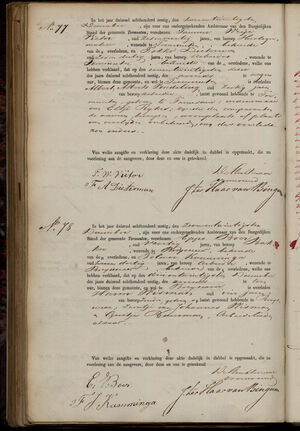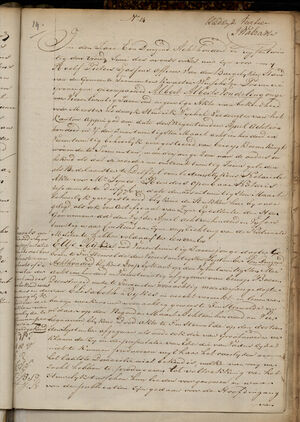Contents |
Biography
Albert Alberts was born about 1800-1801 in a village called Farmsum near the city of Delfzijl. He passed away in 1860. At his wedding in Termunten, 1825, Albert Alberts Vondeling, farmhand from Wirdum, submitted statements from the mayor of Delfzijl, the military authorities, and the justice of the peace of Appingedam.
The mayor issued a certificate of incapacity for the groom and his bride. According to the military certificate, the groom's year of birth was 1801, but his exact birthplace is unknown. Most interesting was the statement of the Justice of the Peace. He reported that Albert was the son of one Elisabeth. After her death the parish of Delfzijl raised him as a foundling - Vondeling means foundling - as his mother was a beggar and his father unknown.
[1]
Two stories seem relevant. The (family of) "Vondelingen" were known for their nickname "de kruudoorns" which means "gooseberries" in the local language. Albert Alberts, along with his late mother, is believed to have been found under a gooseberry bush.
Another "family" story tells that one of the ancestors (not Albert) came back from the battlefields of Napoleon in Russia. That could be the father of Albert Alberts. The names of the soldiers are registered in special military files. Near his birthplace Farmsum a French legion was situated that occupied the city of Delfzijl.
There could be an interesting theory about the childhood of the boy. In Farmsum lived a woman named Elizabeth Alberts. She was married with Nicolaas Redeker. They had several children which all were baptized. One of them had the name Albert and was baptized in December 1801. Of course we don't know the name of the real mother and probably was she a beggar. The temperature of December 1801 was average 1,5 degree Celsius. Winters were much colder than nowadays. I can imagine that she died of cold. They found the baby near her. There is no birth certificate of the child. The baby had of course to be nursed. A mother who had lost a child or feed another young chil could provide the milk for the boy. The name Elizabeth was later a common name in the family as it was Albert. Albert's was full named Albert Alberts which means Son of Alberts. When one of the children of Elizabeth died earlier there is a chance that she could adopted the child. The family was religious and the church payed for him.
Marriage
He married Eltje Aijkes (1800-1860) on 4 June 1825 in Termunten, Groningen, Nederland [2]
Death
He passed away on 21 December 1860, in Termunten, Groningen, Nederland [3]
Sources
- ↑ https://groninganus.wordpress.com/?s=albert+alberts
- ↑ Groom : Albert Alberts Vondeling
Bride : Eltje Rijkes
Opmerking: moeder bruidegom was bedelares; wettiging van 1 kind
Burgerlijke Stand Huwelijk 1825, Termunten, Groningen, Nederland. Akte 14 (1825-06-04), Groninger Archieven accessed via WieWasWie Permalink - ↑ Burgerlijke Stand Overlijden 1860, Termunten, Groningen, Nederland. Akte 77 (1860-12-22), Groninger Archieven accessed via WieWasWie Permalink
Farmsum Farmsum (Gronings: Faarmsom) is a village in the municipality of Eemsdelta, immediately southeast of Delfzijl. The village has 1,615 inhabitants (2020). The northwestern old part of the village is located on a mound.
Around the year 1000, the village of Farmsum was first spoken of: Fretmarashem. This name can be explained as 'hometown of Fretmar ("Vredemaar")'. In the year 1228 there was mention of Fermeshem. At the end of the 14th century the name was written as Fyrmesen and later as Fermissum and Farremsem. The administration of justice, including the deanery over the east of Fivelingo and the Oldambten, was then in the hands of the Ripperdas, the residents of the Huis te Farmsum.
Farmsum was briefly an independent municipality in 1809 during the French period. The French had the plan to make Farmsum and Delfzijl a twin fortress. This would mean Farmsum would become a fortress, but the plan came to nothing. During the siege of Delfzijl (1813-1814) Farmsum suffered greatly from the shelling and sorties of the French and because the field of fire around the fortress had to be cleared.
When Farmsum is first mentioned in the written sources, this place must have been centuries old. During excavations, various objects have been found from the mound of Farmsum, such as a pair of bone skates, pots from the first centuries of the era, bone combs from the fifth and ninth century. On a list of income of the abbey Werden on the Ruhr from goods from Friesland, from about the year one thousand, the village appears for the first time as Fretmarashem. Fermeshem is mentioned in a charter by Theodoricus, abbot of Dokkum from 1228.
At the end of the fourteenth century it is written as Fyrmesen, Fermesen and Fermissum. In later times one also sees Farrempsum, Farrumpsum to finally become Farmsum for good. Not much can be found in the older sources about the village itself. The highest part was called the Vliethorn. Farmsum has repeatedly suffered from war violence. In 1515 it was looted and set on fire by the Duke of Saxony, on a raid from Appingedam. In 1814 more than half of the village was destroyed. On January 19 of that year, the French occupation of Delfzijl made a sortie, confiscating livestock and food. Many houses were demolished to have a wider view from the fortress. The flour mill was set on fire. The French had built batteries east, south and west of Farmsum, which in 1828 were still in good condition.
With the municipal division of 1808 (Albert was about 7 years old) Farmsum initially became an independent municipality to which, in addition to Farmsum, Opwierde, and Eelwerd, Amsweer and Tuikwerd, Meedhuizen, Weiwerd, Heveskes, Oosterwierum and Oterdum belonged. However, in 1811, with the new layout, Farmsum was added to the municipality of Delfzijl. Over time, the village image has changed significantly. Three very characteristic elements that defined this village image have disappeared. In 1812 the deposit was demolished, in the middle of the 19th century the tower and church were replaced and in the 1920s it was deeply filled in.
The churchwardens of Farmsum received a letter from the Committee for Provision in Extraordinary Circumstances in the Municipality of Delfzijl on September 7, 1914, to start filling in the canal 'which runs along the Nieuwstad in Farmsum to the Afwateringskanaal in order to combat unemployment. '. This foreshadowed a decision that would completely change Farmsum's face. You can see how big this difference is if you compare the photo of about 1860 with the current situation. The committee was of the opinion that the church should bear the costs amounting to f.7539,- because this work 'will cause the improvement and beautification of the village of Farmsum'. The churchwardens fully agree with this last statement, but do not see why they should pay this. This is very clear to the committee 'because in place of the now existing deep, often in a dirty, at least stale condition, there will be a nice square', 'which will greatly benefit public health'. And now comes a statement that many will not agree with now: 'the aesthetic appearance of the village of Farmsum will also be improved'. (bron: https://www.farmsum.net/)
Delfzijl is a small port town located in the northern region of the Netherlands. During its long history, the town has been subject to various occupations and invasions, including a period of French occupation in the late 18th and early 19th centuries.
The French occupation of Delfzijl began in 1795, when the armies of the French Republic under the command of General Jean-Charles Pichegru invaded the Netherlands. The Dutch Republic, weakened by internal divisions and the threat of invasion from Britain, was unable to resist the French forces, and many Dutch cities, including Delfzijl, surrendered without a fight.
The French occupation of Delfzijl lasted for several years and had a significant impact on the town and its people. The French authorities implemented a range of measures designed to assert their control over the town and its inhabitants. They established a local administration, introduced new laws and regulations, and began to impose taxes and tariffs on the town's residents.
One of the most significant changes brought about by the French occupation was the introduction of the metric system. The French authorities saw the metric system as an essential tool for modernizing the economy and improving trade, and they made it mandatory in Delfzijl and throughout the Netherlands. The metric system remains in use in the Netherlands to this day.
Despite the many changes brought about by the French occupation, it was not universally popular among the people of Delfzijl. Many locals resented the French presence and saw them as foreign oppressors. There were several instances of resistance and rebellion during the occupation, including an uprising in 1799 led by a local farmer named Pier Schuiringa.
The French occupation of Delfzijl came to an end in 1814, following the defeat of Napoleon Bonaparte and the restoration of the Dutch monarchy. The town was returned to Dutch control, and many of the French measures were reversed or modified. However, the French occupation had a lasting impact on the town and the wider region, particularly in terms of the introduction of the metric system and the modernization of the economy.
In the Netherlands around 1800, there were many foundlings. Foundlings were newborn babies who were abandoned by their parents and then taken in by the community. Leaving a child was not uncommon at that time, especially among unmarried mothers or parents who could not afford to care for a child.
It was the responsibility of local authorities to care for foundlings. Municipalities were required to take in and care for foundlings until they were old enough to care for themselves or until an adoptive family could be found for them. In some cases, foundlings were placed in a home or orphanage.
In 1811, the Civil Registry was introduced in the Netherlands, which meant that the birth of a child had to be registered and that parents were no longer able to abandon their children anonymously. This resulted in a sharp decrease in the number of foundlings in the years that followed.
It may be possible to confirm family relationships with Albert Alberts by comparing test results with other carriers of his Y-chromosome or his mother's mitochondrial DNA. However, there are no known yDNA or mtDNA test-takers in his direct paternal or maternal line. It is likely that these autosomal DNA test-takers will share some percentage of DNA with Albert Alberts:
-
~6.25%
Henk Vondeling
 :
Autosomal DNA Test, GEDmatch HD3350176 [compare]
:
Autosomal DNA Test, GEDmatch HD3350176 [compare]
Have you taken a DNA test? If so, login to add it. If not, see our friends at Ancestry DNA.
Featured National Park champion connections: Albert Alberts is 19 degrees from Theodore Roosevelt, 21 degrees from Stephanus Johannes Paulus Kruger, 19 degrees from George Catlin, 22 degrees from Marjory Douglas, 27 degrees from Sueko Embrey, 21 degrees from George Grinnell, 24 degrees from Anton Kröller, 21 degrees from Stephen Mather, 26 degrees from Kara McKean, 19 degrees from John Muir, 22 degrees from Victoria Hanover and 30 degrees from Charles Young on our single family tree. Login to find your connection.



